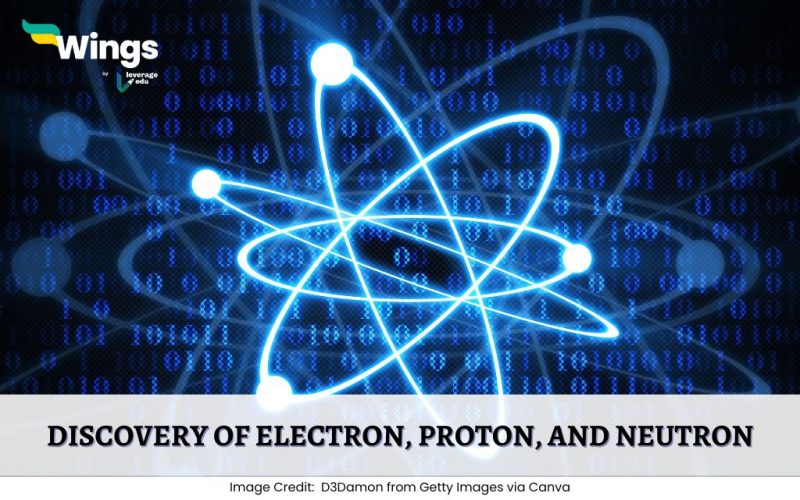The atoms that make up our world are more complex than we know. They are composed of tiny particles called electrons, protons and neutrons. The discovery of electron, proton, and neutron was an event that shaped modern science. It shattered the ancient belief that atoms are invisible. Starting from J.J. Thomson’s ray experiments to the nuclear model of Rutherford, discoveries have changed how we understand our universe. In this blog, we will understand who discovered the electrons, protons and neutrons, and most importantly how?
Table of Contents [show]
Discovery of Electron, Proton, and Neutron – Who, When, & How
Let’s take a look at the following table to understand briefly who, when, and how discovered electrons, protons, and neutrons here:
| Particle | Discovered By | Year | Discovery Details |
| Electron | J.J. Thomson | 1897 | Discovered using cathode ray tube experiments; proposed as a subatomic particle. |
| Proton | Ernest Rutherford | 1917 | Identified during gold foil experiment follow-ups; observed hydrogen nuclei in atoms. |
| Neutron | James Chadwick | 1932 | Discovered through experiments with beryllium and alpha particles; confirmed as neutral particles. |

What is an Electron?
An electron is a negatively charged subatomic particle. This particle orbits around the nucleus of an atom. An electron has a tiny mass (~1/1836 of a proton), and determines the chemical behaviour of an atom.
They allow electricity to flow through conductors. For example, like electricity flowing through copper wires. They exist in a cloud-like form around the nucleus. They have no known substructures. The discovery of electron proton and neutron changed the belief that you cannot see an atom. Electrons were the first to be discovered.
Who First Discovered the Electron?
Do you want to know who discovered the electron? The electron was first discovered by J.J. Thomson in 1897. His cathode ray tube experiment was a success. J.J. Thomson showed that the cathode rays were negatively charged particles, and must not be confused with electromagnetic waves. This discovery earned him a Nobel Peace Prize in physics. Thereafter, his work became the foundation for quantum theory and electronics.
How Was the Electron Discovered?
Among the discovery of electron proton and neutron learn how the electrons were discovered. Thomson passed an electric current through a gas (low pressure) in a cathode ray tube He found that rays bent toward a positive plate. This provided that they had a negative charge. After measuring their deflection, they calculated their charge-to-mass ratio. Thus, he was able to confirm that electrons were an important component of atoms.
What is the Old Name of the Electron?
After discovering the electron, Thomson called them “corpuscles. Corpuscles actually mean tiny bodies. It was George Stoney who gave electrons their name. In 1891, he used the Greek word ēlektron (amber) to describe the particle. The word ēlektron was linked to static electricity. After Thomson’s discovery, the name electron was used as he validated Stoney’s work on electric charge.
What is a Proton?
The second in the discovery of electron proton and neutron is the proton. Unlike electrons, protons are positively charged particles in the atom’s nucleus. This means they are heavier as well. They weigh around 1,836 times more than an electron. Moreover, they can define an element’s atomic number. For example, the air we breathe (oxygen) consists of 8 protons. Protons play a key role in nuclear reactions. For example, fusion of stars like the Sun.
Who First Discovered the Proton?
The man who discovered protons was Ernest Rutherford, who discovered protons in 1917. However, it was Eugen Goldstein who was able to identify that the canal rays are positively charged ions. In 1886. While Rutherford’s experiments were able to discover that protons are nuclear particles, it was Goldstein’s work that inspired him to discover protons.
Did Rutherford or Goldstein Discover the Proton?
Goldstein was the person who discovered the canal rays. However, he couldn’t say that they were protons. Later on, Rutherford was able to prove the existence of protons by adding nitrogen with alpha particles, producing hydrogen nuclei (protons). Therefore, the credit for the discovery of protons goes to Rutherford.
How Was the Proton Discovered?
Want to know discovery of electron proton and neutron? In 1911, Rutherford conducted the gold foil experiment. This experiment was able to reveal the atomic nucleus. Thereafter, he included the alpha particles into nitrogen gas and was able to detect hydrogen nuclei. He called these particles protons. The name of the same was taken from a Greek word called protos or first as they were the first nuclear particles that was identified.
Who Discovered Proton Decay?
Proton decay is not something that has been discovered. Instead, it is a theoretical concept that is predicted by the Grand Unified Theories (GUTs) in the 1970s. Experiments like the Super-Kamiokande in Japan were unable to confirm this. However, it is assumed that if the protons decay, then their lifespan can exceed 10³⁴ years. This means they can live longer than the universe itself!
What is a Neutron?
A neutral particle in the atomic nucleus is called a neutron. This means its mass is the same as the proton and can stabilise the nucleus by counteracting proton repulsion. For example, carbon-14 consists of 8 neutrons. Neutrons play an important role in nuclear fission. They also play a key role in atomic bombs.
What are Neutrons Made Of?
Now you know about the discovery of electron proton and neutron. Want to know what neutrons are made of? Neutrons consist of 3 quarks. That is, one up quark (+2/3 charge), and 2 down quarks (-1/3 each). They total to 0 charge. A strong force binds these quarks. Moreover, they are mediated by gluons. Neutrons outside the nuclei are not stable. Such neutrons can decay into protons in 15 minutes.
Who First Discovered the Neutron?
Among the discovery of electron proton and neutron, let’s understand who discovered the neutron. James Chadwick (1932) was able to identify the neutrons. His experiments with beryllium and paraffin wax were able to discover the same. The discovery of neutrons earned him a Nobel Prize in Physics in 1935.
How Was the Neutron Discovered?
Chadwick added beryllium with alpha particles. This released radiation that ejected protons from paraffin. The radiation was not deflected by the electric fields. Therefore, he concluded the experiment by proving that it was neutral particles (neutrons). His discovery was able to explain the atomic mass discrepancies and changed the study of nuclear physics forever.
To learn more about electrons, protons and neutrons, watch this 4 minute video:
What is the Smallest Particle?
The smallest identified particles are the quarks and leptons. That is, the electrons. Quarks make up the protons and neutrons. On the other hand, the leptons include neutrinos and electrons. As per the string theory, the particles are vibrations of tiny strings. However, this is not yet proven As per current research (held at CERN), efforts are being made to identify even more small particles.
Also Read-
- The Evolution of Computers: 10 Interesting Facts You Didn’t Know
- Thomas Edison Facts: 10 Insights About the Inventor of the Light Bulb
- Facts About the Law of Physics: 10 Fundamental Principles Explained
FAQs – Discovery of Electron, Proton, and Neutron
Eugen Goldstein was able to discover the protons (canal rays) in the year 1886. He used a perforated cathode tube to discover these rays. The rays were travelling in the opposite direction to electrons, showcasing that they are positively charged particles. However, despite his contributions, his work is overshadowed by the work of Rutherford and Thomson.
The full name of E Goldstein is Eugen Goldstein. He was a German physicist known for his work on the electrical phenomena in gases. He is also known for discovering what is called canal rays. Later on, it was discovered that what he refers to as canal rays are actually protons.
Robert Millikan is a Nobel Prize-winning physicist known for identifying the value for the electron charge. His famous oil drop experiment, which was a success, and he was able to discover the same.
The scientist who discovered the neutron is James Chadwick. He discovered the neutron in 1932. He believed that it was a new elementary particle different from protons.
The value of g is 9.8 meters per second squared (m/s²). This refers to the acceleration due to the gravity near the Earth’s surface.
Related Reads
Hope you have understood everything about discovery of electron proton and neutron. If you find it fascinating and wish to read more such interesting facts, then stay tuned to the General Knowledge page of Leverage Edu.
 One app for all your study abroad needs
One app for all your study abroad needs















 45,000+ students trusted us with their dreams. Take the first step today!
45,000+ students trusted us with their dreams. Take the first step today!
